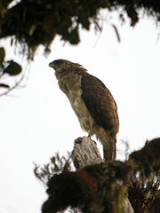
New Guinea Harpy Eagle
Encyclopedia
The Papuan Eagle also known as the Papuan Harpy Eagle, New Guinea Eagle, or Kapul Eagle, is a huge (up to 90 cm long) greyish brown raptor
with a short full crest, broad three-banded wings, powerful beak, large iris
, long rounded tail and white underparts. It has long and powerful unfeathered legs with sharp claws. The sexes are similar, and the female is slightly larger than the male. It is the only member of the monotypic genus Harpyopsis.
The Papuan Eagle is endemic
to undisturbed tropical rainforests of New Guinea
, where it became the top predator of the island. The diet consists mainly of phalangers
or Kapul in a local language, hence its alternative name. It also feeds on other mammals, birds and snakes.
One of a group of four large eagles, the others being the Crested
and Harpy Eagle of South America
and the Philippine Eagle
of the Philippines
, the New Guinea Harpy Eagle is essentially a mountain bird that nests in high forest trees.
Due to ongoing habitat loss, small population size, and hunting for its feathers which are used on ceremonial occasions, the Papuan Eagle is evaluated as Vulnerable
on the IUCN Red List
of Threatened Species. It is listed on Appendix II of CITES.
Bird of prey
Birds of prey are birds that hunt for food primarily on the wing, using their keen senses, especially vision. They are defined as birds that primarily hunt vertebrates, including other birds. Their talons and beaks tend to be relatively large, powerful and adapted for tearing and/or piercing flesh....
with a short full crest, broad three-banded wings, powerful beak, large iris
Iris (anatomy)
The iris is a thin, circular structure in the eye, responsible for controlling the diameter and size of the pupils and thus the amount of light reaching the retina. "Eye color" is the color of the iris, which can be green, blue, or brown. In some cases it can be hazel , grey, violet, or even pink...
, long rounded tail and white underparts. It has long and powerful unfeathered legs with sharp claws. The sexes are similar, and the female is slightly larger than the male. It is the only member of the monotypic genus Harpyopsis.
The Papuan Eagle is endemic
Endemism in birds
An endemic bird area is a region of the world that contains two or more restricted-range species, while a "secondary area" contains one or more restricted-range species. Both terms were devised by Birdlife International....
to undisturbed tropical rainforests of New Guinea
New Guinea
New Guinea is the world's second largest island, after Greenland, covering a land area of 786,000 km2. Located in the southwest Pacific Ocean, it lies geographically to the east of the Malay Archipelago, with which it is sometimes included as part of a greater Indo-Australian Archipelago...
, where it became the top predator of the island. The diet consists mainly of phalangers
Phalangeridae
Phalangeridae is a family of nocturnal marsupials native to Australia and New Guinea, including the cuscuses, brushtail possums, and their close relatives...
or Kapul in a local language, hence its alternative name. It also feeds on other mammals, birds and snakes.
One of a group of four large eagles, the others being the Crested
Crested Eagle
The Crested Eagle is a large Neotropical eagle. It is the only member of the genus Morphnus. It is 71–89 cm long and has a wingspan of 138–176 cm...
and Harpy Eagle of South America
South America
South America is a continent situated in the Western Hemisphere, mostly in the Southern Hemisphere, with a relatively small portion in the Northern Hemisphere. The continent is also considered a subcontinent of the Americas. It is bordered on the west by the Pacific Ocean and on the north and east...
and the Philippine Eagle
Philippine Eagle
The Philippine Eagle , also known as the Monkey-eating Eagle, is an eagle of the family Accipitridae that is endemic to forests in the Philippines. It has brown and white-coloured plumage, and a shaggy crest, and generally measures in length and weighs...
of the Philippines
Philippines
The Philippines , officially known as the Republic of the Philippines , is a country in Southeast Asia in the western Pacific Ocean. To its north across the Luzon Strait lies Taiwan. West across the South China Sea sits Vietnam...
, the New Guinea Harpy Eagle is essentially a mountain bird that nests in high forest trees.
Due to ongoing habitat loss, small population size, and hunting for its feathers which are used on ceremonial occasions, the Papuan Eagle is evaluated as Vulnerable
Vulnerable species
On 30 January 2010, the IUCN Red List of Threatened Species identified 9694 Vulnerable species, subspecies and varieties, stocks and sub-populations.-References:...
on the IUCN Red List
IUCN Red List
The IUCN Red List of Threatened Species , founded in 1963, is the world's most comprehensive inventory of the global conservation status of biological species. The International Union for Conservation of Nature is the world's main authority on the conservation status of species...
of Threatened Species. It is listed on Appendix II of CITES.

